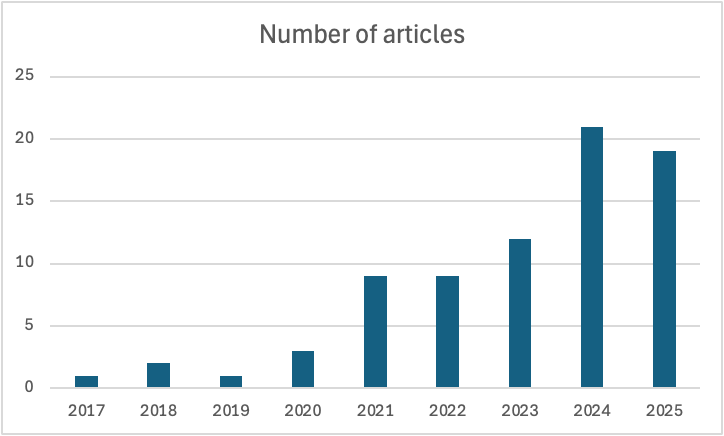Presenting NORTASUN: An exploratory study of gender transition and detransition among Spanish-speaking adults
NORTASUN is a mixed-methods exploratory study led by Pablo that looks at the experiences and needs of trans, nonbinary, and detrans people
Compared to the US, Canada, and other Western European countries, the issues of detransition, retransition, and gender fluidity are relatively unknown to many people in the Spanish-speaking world. In Spain, some detransitioners and people who once affirmed a trans identity and later socially detransitioned have shared their stories publicly on social media, television programs, and relevant newspapers, but their experiences have not attracted much attention.
The trend of increasing numbers of English academic publications on detransition has also not been mirrored by an increase in Spanish articles. Quite the contrary, in fact. Since the publication of two case reports and a review of medical histories between 2020 and 2022, there haven’t been any new empirical publications about detransition in Spain or any other Spanish-speaking country that I know of.
This means that, despite growing awareness of its relevance as a politicized, socio-medical phenomenon in the Anglosphere, we still lack empirical information and knowledge to support people who go through this complex and often challenging process—especially in the Spanish-speaking world.
Since I had already developed an interest in improving trans and nonbinary health during my undergraduate and master’s years, I thought that pursuing a PhD in psychology could be a good opportunity to design a study that would address this gap. This is how NORTASUN (a word for “identity” in Basque, a regional language from Northern Spain) was conceived.
As far as I’m aware, NORTASUN is the first study explicitly designed to explore the experiences, needs, and mental health of trans, nonbinary, and detransitioning people in the Spanish-speaking world. Indeed, one of the most novel aspects of the study is that all these gender diverse experiences were included and studied together in a single study.
This is because it’s not only important to learn about detransition; we also need to know more about the experiences and needs of trans and nonbinary people, and how these might overlap or differ. After all, literature about trans people in the Spanish-speaking context is not that abundant, and we can’t assume that both populations share the same experiences or needs just because they have socially and/or medically transitioned.
NORTASUN aimed to recruit trans, nonbinary, and detransitioning people, regardless of how they identified at the time of participation or the steps they had taken to transition or detransition. Our intention was to be inclusive of all kinds of experiences and self-understandings of transition and detransition, so as not to exclude participants who didn’t fit neatly into each category (humans are really complex and this happens more than we think!).
The main goals of the study were:
To understand participants’ experiences and trajectories of gender transition and detransition, as well as potential similarities and differences;
To identify participants’ psychological needs to improve existing care services and practices; and
To develop recommendations for mental health support for trans, nonbinary, and detransitioning people.
Similar to the DARE study led by Kinnon (you can read more about it in this post), NORTASUN was a mixed-methods study in that it collected both qualitative and quantitative data in the same study. However, unlike the DARE study, this was done concurrently rather than sequentially: all participants participated in a face-to-face interview and complete a series of self-report questionnaires.
To be able to take part in the study, participants needed to:
Identify as transgender, nonbinary, gender diverse, or as having detransitioned, regardless of whether they had taken social and/or medical steps during their gender transition;
Be at least 18 years old; and
Reside in a Spanish-speaking country and be fluent in Spanish.
Since NORTASUN was conceived as a PhD project, the research team was very small. In fact, it was just me (Pablo) and my two supervisors, both associate professors at the Faculty of Psychology of the University of the Basque Country in Spain.
When we first designed the study, between 2021 and 2022, there was simply too little information on detransition to know what variables to look at. The only available community studies at the time were two cross-sectional online surveys by Lisa Littman and Elie Vandenbussche, and a secondary analysis of the US Transgender Survey 2015 by Turban and colleagues. Although these were very useful in conceptualizing some aspects of our study, our focus was on mental health care and support, so we didn’t have many sources to refer to. We didn’t even have any hypotheses about what to expect from the findings!
In addition, as we wanted to make comparisons between trans and detransitioning participants, we had to make sure that everything in the study (recruiting materials, interview guides, questionnaires, etc.) was appropriate and sensitive to the specific characteristics of both groups.
In the end, we thought we would design a study in the traditional psychological way: semi-structured biographical interviews covering participants’ histories from childhood onwards, and well-established, validated questionnaires covering as many aspects as possible of participants’ gender experiences, mental health, and quality of life.
Between January 2023 and June 2024, over 50 participants gave their consent and took part in the study. They all attended two separate face-to-face sessions, one for the semi-structured interview (which lasted between one and four hours) and one for the questionnaires.
One thing that makes NORTASUN unique is its comparative approach. The study’s main goal was not only to describe trans and detrans participants, but also to understand how they relate to one another in terms of their experiences and needs. This approach was incorporated into every step of our data analysis.
To conduct the comparisons, we divided the participants into two groups: a trans group and a detransition group. The detransition group included participants who reported both (1) having stopped, shifted, or reversed their gender transition and (2) having experienced a shift in their gender self-understanding after transitioning. Both of these criteria were required to belong to the detransition group. The remaining participants were included in the trans/nonbinary group.
For the quantitative data, we used robust statistical tests to directly compare the questionnaire scores from both groups. This allowed us to pinpoint where their experiences were statistically similar or different, revealing key patterns regarding their gender experiences, mental health, and quality of life.
For the qualitative analysis, we used comparative thematic analysis, a method that involves systematically analyzing the narratives of both groups of participants side-by-side. This enabled us to identify shared and divergent experiences and needs, as well as significant differences in how each group understood and made sense of their gender trajectories and experiences.
The analysis of the of data has resulted in five empirical articles, one of which has been accepted and will be published shortly. The remaining are currently undergoing peer review at different journals.
We hope the full results will be available to the public in 2025 and 2026. We will keep you updated as the articles are published!
In the meantime, if you would like to know more about NORTASUN, I invite you to visit our website (available in Spanish only) or leave a comment below!
Thank you for reading The One Percent!
If you enjoyed this post, please share it with your friends, family, or colleagues:
You can also subscribe for free to receive new posts and support our work:







Pablo, does "NORTASUN" mean something in Spanish that isn't conveyed in English? Or is it an acronym that isn't understood in English? :) excited to see the articles